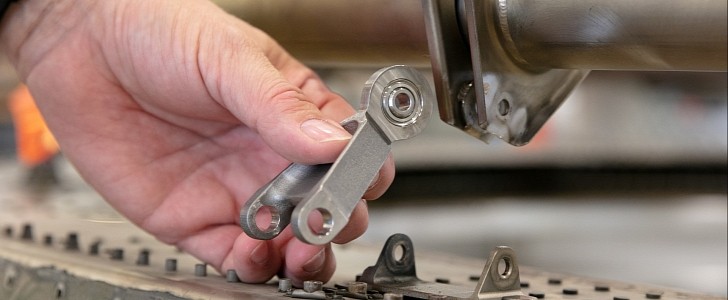3D printing has proven its efficiency in the aerospace industry, and a recent milestone confirms that there are still many interesting applications to explore. This small metal component is no ordinary spare part but the first 3D-printed load-bearing metallic part approved for aerospace use.
In order to be protected from ice buildup, an aircraft engine needs something called an “A-Link.” According to Lufthansa, several of these A-Links are used as essential components for the ring-shaped hot air duct in the engine's inlet cowl, but due to the intense vibrations, they usually need to be replaced after just a few years.
Together with Premium Aerotec, an expert in additive manufacturing, Lufthansa has developed an innovative A-Link for its IAE-V2500 engine.
Instead of manufacturing it through a forging process, this metal spare part was built layer by layer in a 3D printer. Because no molds are required, this innovative process called Laser Power Bed Fusion (LPBF) saves precious material.
The component that was obtained through this process is not only as efficient as a conventional A-Link, but it seems to be even better in terms of tensile strength.
Premium Aerotec has been using additive manufacturing since 2016 but mostly producing plastic components for the aircraft cabin. This collaboration with Lufthansa proved that this technology can be just as useful for making metal parts that are used outside the cabin.
This 3D-printed A-Link developed at Lufthansa’s Additive Manufacturing (AM) Center received official certification from EASA (the European Union Aviation Safety Agency), giving Premium Aerotec the green light to start producing it for Lufthansa at its site in Varel, Germany, with the help of a 3D printer.
Lufthansa is the second customer to which Premium Aerotec has provided spare parts obtained through additive manufacturing. Until now, Airbus has been the only one.
The main goal was to reduce costs for this particular component without compromising its efficiency. But the success of this innovative process encouraged both the German operator and Premium Aerotec to explore the future possibility of extending it for other metal parts as well.
Together with Premium Aerotec, an expert in additive manufacturing, Lufthansa has developed an innovative A-Link for its IAE-V2500 engine.
Instead of manufacturing it through a forging process, this metal spare part was built layer by layer in a 3D printer. Because no molds are required, this innovative process called Laser Power Bed Fusion (LPBF) saves precious material.
The component that was obtained through this process is not only as efficient as a conventional A-Link, but it seems to be even better in terms of tensile strength.
Premium Aerotec has been using additive manufacturing since 2016 but mostly producing plastic components for the aircraft cabin. This collaboration with Lufthansa proved that this technology can be just as useful for making metal parts that are used outside the cabin.
This 3D-printed A-Link developed at Lufthansa’s Additive Manufacturing (AM) Center received official certification from EASA (the European Union Aviation Safety Agency), giving Premium Aerotec the green light to start producing it for Lufthansa at its site in Varel, Germany, with the help of a 3D printer.
Lufthansa is the second customer to which Premium Aerotec has provided spare parts obtained through additive manufacturing. Until now, Airbus has been the only one.
The main goal was to reduce costs for this particular component without compromising its efficiency. But the success of this innovative process encouraged both the German operator and Premium Aerotec to explore the future possibility of extending it for other metal parts as well.







